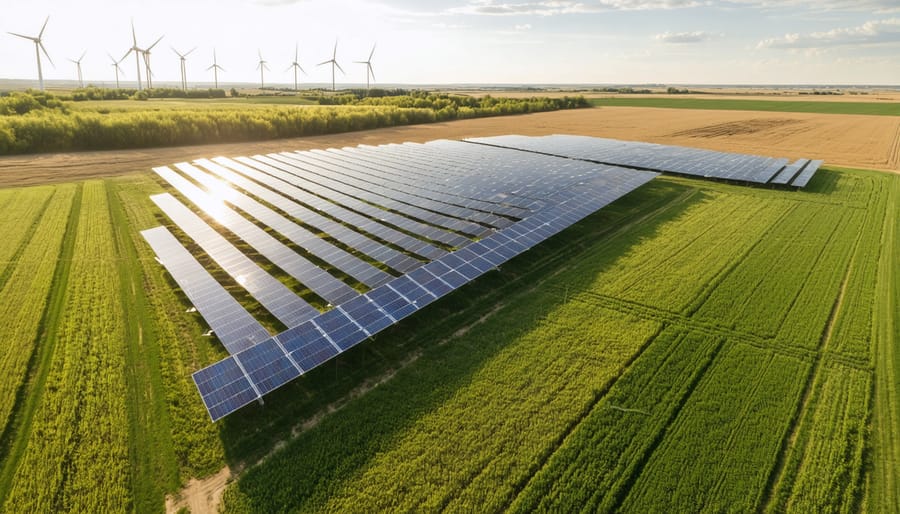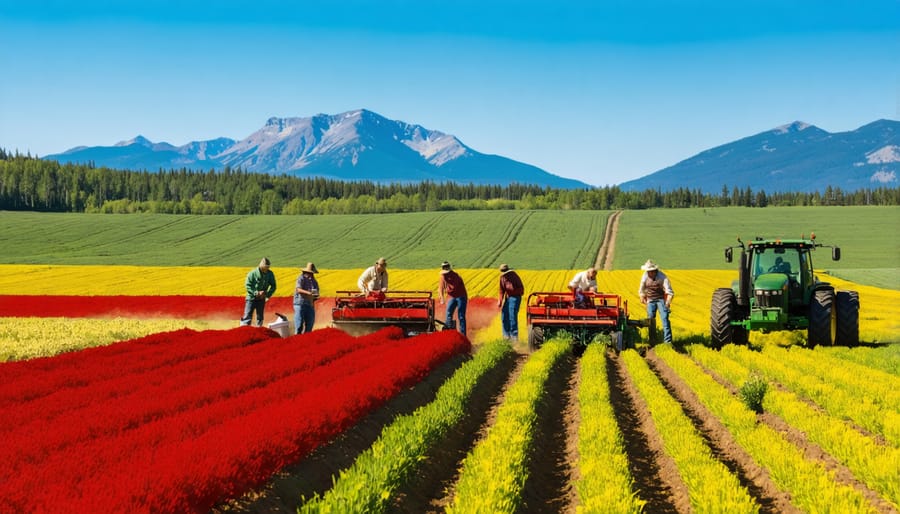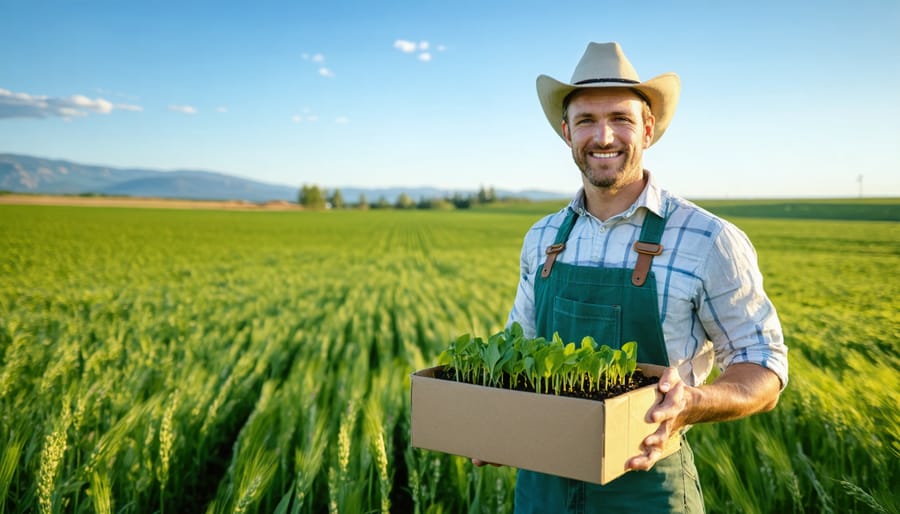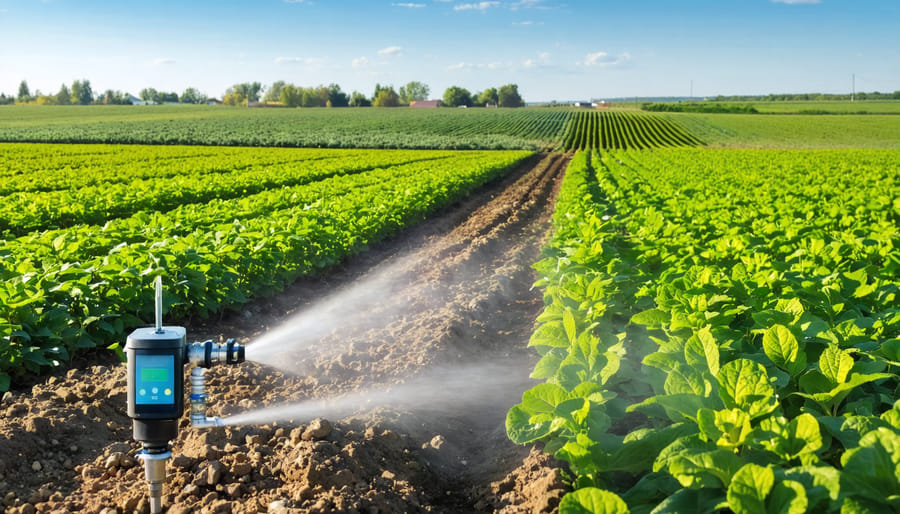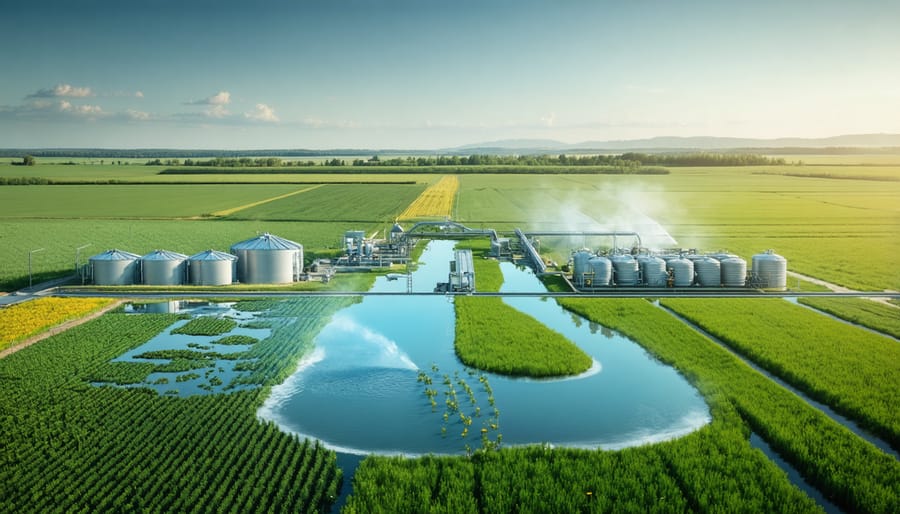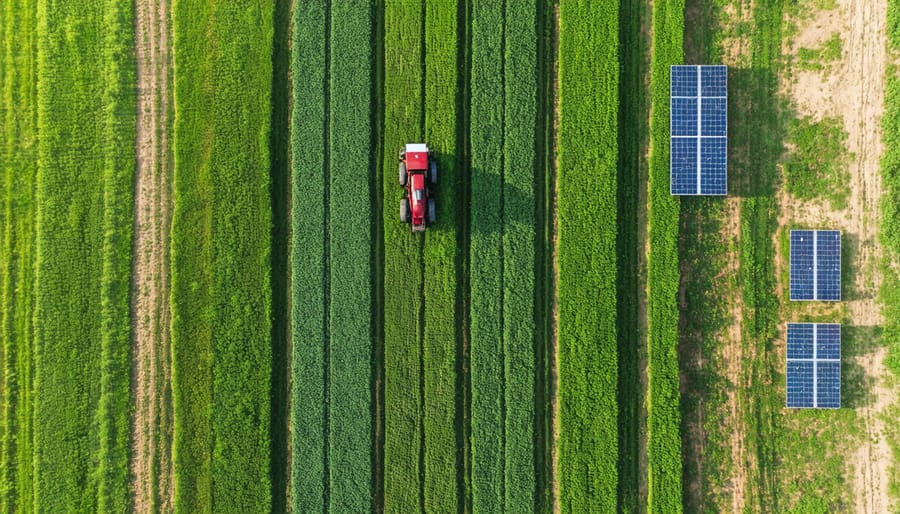Transforming Alberta’s agricultural landscape through renewable energy isn’t just an environmental choice—it’s a strategic business decision reshaping our farming future. As energy costs continue to rise, innovative sustainable agricultural practices incorporating solar, wind, and biomass solutions are delivering 30-40% reduction in operational costs across local farms. From Lethbridge’s wind-powered irrigation systems to Red Deer’s solar-heated greenhouses, Alberta’s farmers are pioneering renewable integration that strengthens both their bottom line and supply chain resilience.
Consider that traditional energy sources account for nearly 15% of agricultural production costs in our region. By transitioning to renewables, forward-thinking farmers are not only hedging against future energy price volatility but also creating new revenue streams through energy export programs. The Alberta Renewable Energy Cooperative reports that participating farms generate an average of $12,000 annually in additional income through grid feed-in programs.
Our changing climate demands adaptive solutions, and renewable energy integration offers practical pathways to maintain productive, profitable operations while building climate resilience. With provincial incentives covering up to 35% of installation costs, there’s never been a better time for Alberta’s agricultural community to embrace this transformative opportunity.
Why Alberta Farms Are Perfect for Renewable Energy Integration
Solar Potential in Southern Alberta
Southern Alberta’s unique geographical position makes it one of Canada’s most promising regions for solar power integration. With over 2,300 hours of sunshine annually and average solar irradiance levels reaching 1,276 kWh/m², the region offers exceptional potential for solar energy harvesting. Local farmers have already begun capitalizing on these natural advantages, with notable success stories like the Henderson Family Farm in Taber, which reduced its annual energy costs by 65% after installing a 100kW solar array system.
The Medicine Hat Community Solar Project demonstrates the scalability of solar initiatives, supporting over 100 local agricultural operations through a shared solar facility. This collaborative approach has made renewable energy more accessible to smaller farming operations. Recent studies by the University of Alberta show that solar installations in the region typically achieve payback periods of 8-12 years, with systems maintaining 80% efficiency for up to 25 years.
These successful implementations highlight how solar energy can provide stable, long-term power solutions while reducing operational costs for agricultural businesses.
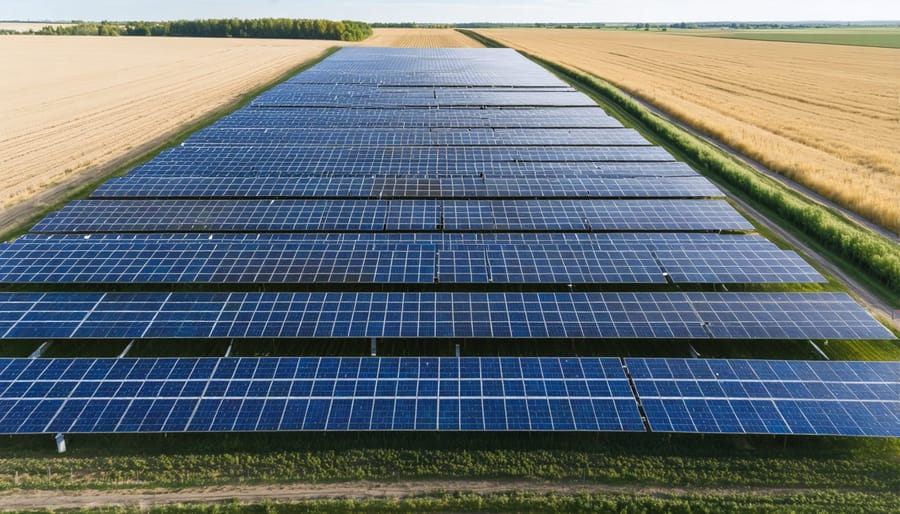
Wind Energy Opportunities
Alberta’s wind energy landscape offers remarkable potential for farmers looking to diversify their operations and reduce energy costs. The province’s southern region, particularly around Pincher Creek and Lethbridge, experiences consistent wind patterns that make it ideal for turbine installations. Many farming operations have already tapped into this resource, with successful installations ranging from single turbines powering individual operations to larger cooperative projects serving multiple farms.
Local farmer Jim Peterson from Cardston County reports generating 60% of his farm’s electricity needs through a 50kW turbine installed in 2019. “The steady winds we get here made it a natural choice,” he explains. “After the initial investment, our energy bills dropped significantly.”
Current wind technology allows for varied installation options, from smaller 10kW systems suitable for individual buildings to larger 100kW setups capable of powering entire farming operations. The Alberta Wind Energy Association notes that modern turbines can operate effectively in wind speeds as low as 13 kilometres per hour, making them viable for many agricultural regions across the province.
Installation costs typically range from $50,000 to $200,000, depending on system size, but various government incentives and rebate programs can offset these initial expenses significantly.
Practical Renewable Solutions for Your Farm Supply Chain
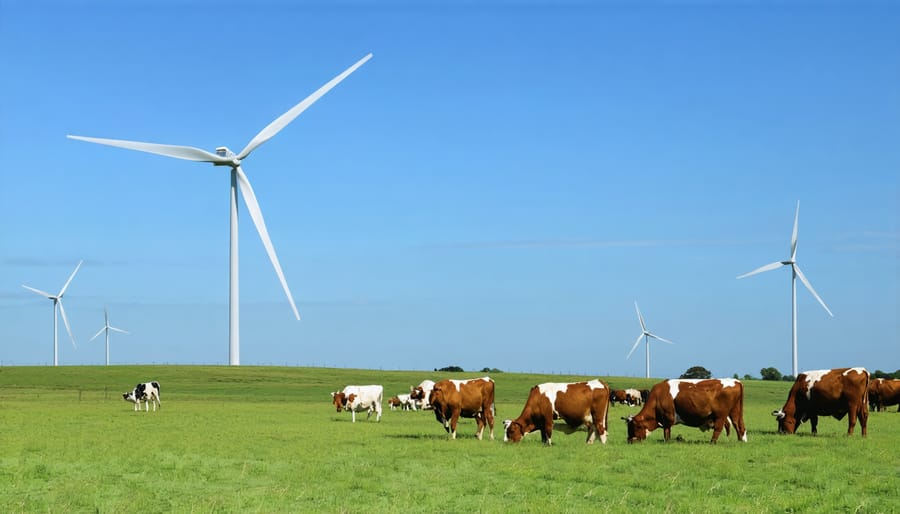
On-Site Power Generation
On-site power generation offers Alberta farmers a practical way to reduce energy costs while supporting sustainable agriculture. Solar panels have become increasingly popular across the province, with many farmers installing systems ranging from 10 to 50 kilowatts to power their operations. These systems perform particularly well in Southern Alberta, which receives over 2,300 hours of sunshine annually, making it one of Canada’s sunniest regions.
Wind turbines are another viable option, especially for properties with average wind speeds above 15 kilometres per hour. Several farms near Pincher Creek have successfully integrated small-scale wind turbines, generating between 5 to 20 kilowatts of power for their operations. These systems work well in combination with solar panels, providing consistent power generation throughout different weather conditions and seasons.
Biogas systems are gaining traction among livestock farmers, converting animal waste into usable energy. A notable example is the Lethbridge Biogas facility, which processes agricultural waste to generate both electricity and heat. Smaller-scale biogas digesters are also becoming more accessible for individual farms, with systems capable of processing 1-5 tonnes of organic material daily.
Local success stories include the Henderson family farm near Red Deer, which reduced its annual energy costs by 65% after installing a hybrid solar-wind system. Their experience demonstrates how combining different renewable technologies can provide reliable year-round power generation while significantly reducing operational costs.
Energy Storage Solutions
As more Alberta farmers embrace renewable energy, effective agricultural energy storage systems have become crucial for maintaining consistent power supply during peak usage periods and weather-related interruptions. Battery storage solutions have evolved significantly, with lithium-ion systems becoming increasingly affordable and reliable for farm operations.
Many local farmers are finding success with hybrid storage solutions that combine batteries with thermal storage systems. These setups help manage energy demands during critical operations like grain drying and livestock barn climate control. For example, the Thompson Family Farm near Red Deer uses a 50 kWh battery system paired with their solar installation, allowing them to operate irrigation systems during nighttime hours and store excess energy generated during peak sunlight.
Beyond traditional batteries, innovative storage methods are gaining traction. Compressed air storage systems are proving effective for larger operations, while thermal storage using phase-change materials helps maintain consistent temperatures in greenhouse operations throughout the winter months.
Local agricultural cooperatives are also exploring community-based storage solutions, where multiple farms share larger-scale storage facilities to reduce individual investment costs. These collaborative approaches have shown promising results, with participating farms reporting 30-40% reductions in peak-time energy costs.
When selecting a storage system, consider factors like daily energy requirements, seasonal variations, and compatibility with existing renewable installations. Many equipment suppliers now offer integrated solutions specifically designed for agricultural applications.
Smart Grid Integration
Connecting renewable energy systems to the wider power grid has become increasingly accessible for Alberta farmers, offering both practical and financial benefits. Through smart grid integration, you can maintain a reliable power supply while contributing excess energy back to the grid, creating a two-way relationship with your utility provider.
The Alberta Electric System Operator (AESO) has streamlined the process for agricultural operations to connect their renewable systems to the provincial grid. This integration allows you to sell surplus power during peak production periods, such as sunny summer days or particularly windy conditions, while drawing from the grid when needed.
Many local farmers have found success with this approach. Take Dave Thompson from Red Deer County, who installed a 50-kilowatt solar array on his grain storage facility. During harvest season, his system powers his operation directly, while in slower periods, excess energy is fed back into the grid, reducing his annual energy costs by 60%.
To get started, you’ll need to work with a certified electrical contractor familiar with agricultural installations. They’ll help ensure your system meets all provincial safety standards and grid connection requirements. Most utility companies in Alberta now offer smart meters as standard equipment, making it easier to track both your energy consumption and production.
Remember to factor in the initial connection costs, which typically range from $5,000 to $15,000, depending on your location and system size. However, provincial grants and incentives often help offset these expenses.
Cost-Benefit Analysis: Real Numbers from Alberta Farms
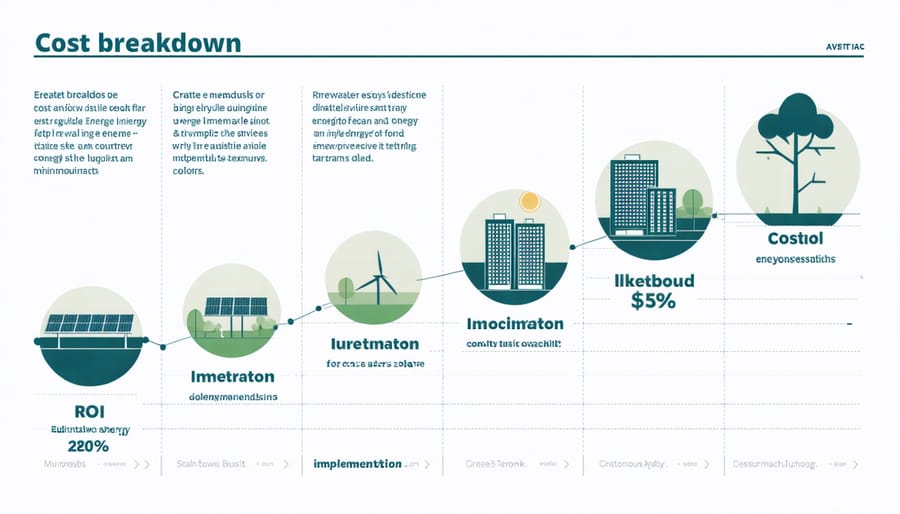
Initial Investment and Available Grants
While the initial investment in renewable energy systems can seem substantial, Canadian farmers have access to numerous farm energy grants and financial incentives that can significantly reduce out-of-pocket expenses. In Alberta, solar installations typically range from $20,000 to $100,000, depending on system size and farm requirements. Wind turbine installations generally start at $40,000 for smaller units.
The Canadian Agricultural Partnership (CAP) offers funding that can cover up to 50% of renewable energy project costs, with maximum contributions of $250,000 per project. Alberta’s On-Farm Energy Management Program provides additional support, offering rebates of up to 70% on solar panel installations and other renewable energy technologies.
Local utilities and municipalities often provide supplementary incentives, including net metering programs that allow farmers to sell excess energy back to the grid. The Clean Technology Program, specifically designed for agricultural operations, offers interest-free loans of up to $350,000 for qualifying renewable energy projects.
For smaller operations, microgeneration grants are available, typically covering 25-35% of installation costs. Many farmers find that combining multiple funding sources can reduce their initial investment by 60-75%, making renewable energy systems significantly more accessible. Return on investment typically ranges from 5-10 years, depending on energy consumption patterns and available incentives.
Long-term Returns and Energy Savings
The long-term financial benefits of renewable energy systems have proven substantial for Alberta farmers. Based on data from local agricultural operations, solar installations typically pay for themselves within 8-12 years, while continuing to generate savings for an additional 15-20 years. For example, the Miller Family Farm in Red Deer reduced their annual energy costs by 65% after installing a 50kW solar array system, saving approximately $12,000 per year.
Wind energy systems in suitable locations show even more impressive returns, with some farmers reporting payback periods as short as 6 years. The combined benefits of government incentives, reduced operational costs, and increasing electricity rates make renewable energy investments increasingly attractive for agricultural operations.
Energy storage solutions, while requiring additional upfront investment, can further enhance these returns by allowing farms to use stored energy during peak rate periods. Several Alberta farmers report achieving complete energy independence during summer months, significantly reducing their reliance on grid power when electricity costs are highest.
Beyond direct cost savings, renewable energy systems provide valuable protection against future energy price volatility. Many farmers also report increased property values and additional income through carbon credit programs. The Thompson Valley Farm, for instance, generates an extra $8,000 annually through carbon credit sales while maintaining their regular agricultural operations.
Consider working with local renewable energy consultants to develop a customized analysis of potential returns for your specific operation. Many offer free initial assessments to help you understand the long-term financial implications for your farm.
Getting Started: Your Renewable Energy Action Plan
Assessment and Planning
Before investing in renewable energy systems, it’s crucial to thoroughly assess your farm’s potential for different renewable resources. Start by conducting a comprehensive energy audit of your current operations, documenting your seasonal energy consumption patterns and identifying peak usage periods.
For solar potential, evaluate your property’s sun exposure throughout the year. Alberta receives an average of 2,300 hours of sunshine annually, making it one of Canada’s sunniest provinces. Consider factors like roof orientation, slope, and structural integrity for solar panel installation. South-facing surfaces typically offer optimal exposure.
Wind energy assessment requires monitoring wind speeds at your location over several months. The ideal site should have average wind speeds of at least 15 km/h. Local weather stations can provide historical wind data, but on-site measurement gives the most accurate results.
For biomass potential, inventory your available organic materials, including crop residues, animal waste, and woodlot resources. Calculate your annual biomass production to determine system sizing requirements.
Remember to consult with renewable energy professionals who understand Alberta’s agricultural context. They can help analyze your site-specific data and recommend the most suitable technologies for your operation. Many agricultural extension services offer free initial assessments and can connect you with qualified contractors.
Consider future expansion plans and how renewable systems might integrate with existing infrastructure. This forward-thinking approach ensures your investment aligns with long-term farm development goals.
Implementation Timeline
A realistic timeline for implementing renewable energy solutions on your farm typically spans 12-24 months, depending on project scope and seasonal considerations. Here’s a practical breakdown that aligns with Alberta’s agricultural calendar:
Phase 1 (Months 1-3): Initial Assessment and Planning
– Energy audit completion
– Site evaluation for solar, wind, or biomass potential
– Consultation with local renewable energy contractors
– Grant application submissions
Phase 2 (Months 4-6): Design and Permitting
– System design finalization
– Municipal permit applications
– Utility interconnection agreements
– Equipment procurement planning
Phase 3 (Months 7-9): Infrastructure Preparation
– Grid connection upgrades
– Foundation work for installations
– Storage facility construction (if required)
– Installation scheduling around harvest times
Phase 4 (Months 10-12): Installation and Testing
– Primary equipment installation
– System integration
– Initial testing and troubleshooting
– Staff training on basic maintenance
Phase 5 (Months 13-15): Optimization
– Performance monitoring
– System adjustments
– Integration with existing farm operations
– Documentation of energy production
Remember that winter installations may face weather-related delays, so planning initial construction during spring or summer is recommended. Many Alberta farmers find success by aligning renewable energy projects with their off-season periods, typically November through March, when farming activities are reduced.
As Alberta’s farming community continues to embrace renewable energy solutions, the opportunities for sustainable agriculture have never been more promising. From solar installations powering irrigation systems to wind turbines supporting grain storage facilities, renewable energy is transforming our agricultural landscape. The benefits extend beyond environmental stewardship – reduced operational costs, enhanced energy independence, and strengthened supply chain resilience make renewable energy a smart investment for forward-thinking farmers. By taking the first step today, whether through a small solar installation or participation in a community renewable energy project, you’ll join a growing network of agricultural innovators shaping Alberta’s sustainable future. Remember, local agricultural extension offices and renewable energy cooperatives are here to support your transition. Together, we can build a more resilient and sustainable agricultural sector for generations to come.

